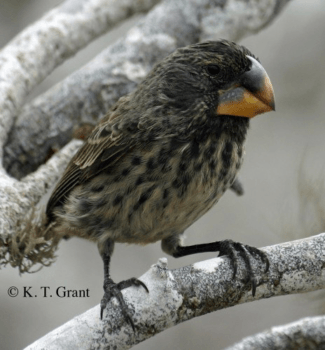Texas A&M Professor Reveals Evolution Of Darwin’s Finches Through Genome Sequencing

Darwin’s finches, inhabiting the Galápagos archipelago and Cocos Island, constitute an iconic model for studies of speciation and adaptive evolution. An international team of scientists, led by Dr. Leif Andersson of the Texas A&M College of Veterinary Medicine & Biomedical Sciences and Uppsala University in Sweden, has now shed light on the evolutionary history of these birds and identified a gene that explains variation in beak shape within and among species. The study is published today in Nature, on the day before the 206th anniversary of Charles Darwin’s birth.
Andersson is a Texas A&M University Institute for Advanced Study Faculty Fellow—one of the nationally and internationally renowned scholars invited by the Institute to come to the campus for extended stays to teach, conduct research and interact with Texas A&M students and faculty.
The finches on the Galápagos Islands were a major influence on Charles Darwin’s theory of evolution through natural selection. The birds’ common ancestor arrived on the Galápagos about 2 million years ago, and since that time the finches have evolved into 15 recognized species differing in body size, beak shape, song and feeding behavior. Changes in the size and form of the beak have enabled different species to utilize different food resources such as insects, seeds and nectar from cactus flowers, as well as blood from iguanas.
“We have now sequenced 120 birds including all known species of Darwin’s finches, as well as two closely related species in order to study their evolutionary history,” said Sangeet Lamichhaney, a Ph.D. student at Uppsala University and shared first author on the paper.
“Multiple individuals of each species were analyzed and for some species birds from up to six different islands were sampled to study variation within and between islands.”
This detailed genetic analysis has allowed the researchers to propose that the 15 recognized species should actually be reclassified to 18. Other insight from the current study was that gene flow between species has played a prominent role throughout the evolutionary history of Darwin’s finches. The scientists could trace clear signs of hybridization between a warbler finch and the common ancestor of tree and ground finches that must have occurred about a million years ago.
“During our field work on the Galápagos we have observed many examples of hybridization between species of Darwin’s finches but the long-term evolutionary effects of these hybridizations have been unknown,” said Peter and Rosemary Grant of Princeton University, who are the world’s experts on the biology of Darwin’s finches after working on the Galápagos for 40 years.
“Now we can safely conclude that interspecies hybridization has played a critical role in the evolution of the finches and has contributed to maintaining their genetic diversity,” Peter Grant continued.

The most striking phenotypic diversity among Darwin’s finches is the variation in the size and shape of the beaks. Charles Darwin was struck by this biological diversity, and compared it with the variety he was accustomed to among European birds such as the hawfinch, the chaffinch and warblers, as documented in his book “The Voyage of The Beagle.” The team investigated the genetic basis for variation in beak shape by comparing two species with blunt beaks and two species with pointed beaks. Fifteen regions of the genome stood out as being very different in this contrast, and as many as six of these contained genes that previously have been associated with craniofacial and/or beak development. One of those genes, called ALX1, was shown to be especially important. The variant of the gene each bird had was strongly correlated with the shape of the bird’s beak.
“The most thrilling and significant finding was that genetic variation in the ALX1 gene is associated with variation in beak shape not only between species of Darwin’s finches but also among individuals of one of them, the medium ground finch,” Andersson said.
The ALX1 gene codes for a transcription factor (a type of protein) that has crucial role for normal craniofacial development in vertebrates, including humans. Genetic mutations that inactivate ALX1 are known to cause severe birth defects, including frontonasal dysplasia, in people.
“This is a very exciting discovery for us since we have previously shown that beak shape in the medium ground finch has undergone a rapid evolution in response to environmental changes,” Rosemary Grant said. “Now we know that hybridization mixes the different variants of an important gene, ALX1.
The ALX1 variants present in the finches have mild effects on ALX1 function, not the sort of devastating effect mutations that cause human disorders. The ALX1 polymorphism in finches is adaptive for the birds, as it has contributed to diversification of beak shapes among Darwin’s finches and, thereby, to an expanded utilization of food resources on the Galápagos.
“This is an interesting example where mild mutations in a gene that is critical for normal development leads to phenotypic evolution,” Andersson said. “I would not be surprised if it turns out that mutations with minor or minute effects on ALX1 function or expression contribute to the bewildering facial diversity among humans.”
Media contacts:
- Megan Palsa, Texas A&M College of Veterinary Medicine.
- Angela G. Clendenin, Texas A&M College of Veterinary Medicine.





